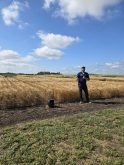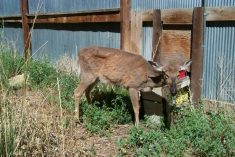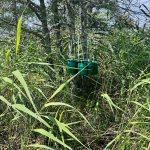The province has its first case of chronic wasting disease (CWD) outside of western Manitoba.
On Jan. 24, the province announced that a hunter-submitted tissue sample from a female white-tailed deer near Winkler in south-central Manitoba had tested positive for CWD.
Chronic wasting disease is a fatal prion disease in the same family as BSE, impacting cervids like deer, elk and moose, and has become widespread in other Prairie provinces.
Read Also

Local Manitoba honey deserves more buzz
Manitoba’s beekeepers harvest local, high quality honey every year —Here are some tips and honey recipes that feature the sweet bounty
The closest positive case in the prior 2022-23 testing program was noted north of Deloraine in the southwest corner of the province. Most positive cases have been identified in areas along the Manitoba-Saskatchewan border. To date, 26 cases have been confirmed in the province since CWD was first detected in Manitoba in 2021.
Most of those cases have been mule deer. Last March, two CWD cases were found in male white-tailed deer, one in the RM of Grasslands and one northwest of Riding Mountain National Park. To date, four white-tailed deer cases have been found, the province said.
The Manitoba government expanded testing for the disease during the 2022-23 hunting season, asking hunters in many areas of the province to submit samples. That year, hunters submitted some 6,000 samples, up from an average of 1,000 in previous years. The sample swell caused testing backlogs, with waits up to 16 and 20 weeks.
In July 2023, the province announced $880,000 in funding and several regulatory changes to try to address the backlog. Hunters were given the option to submit tissue samples rather than the whole head and upper neck and were given seven days rather than two to turn in the sample.
The Wildlife Health Program also expanded its partnership to labs outside of Canada, as labs in Canada were previously overwhelmed with testing requests.
Testing requirements for bovine tuberculosis were also removed, as Manitoba has been considered free of that illness since 2016.
Backlogs continued to be reported as the 2023 hunting season drew to a close, however. In December, hunters were waiting two to four weeks between submitting samples and getting results, the province said at the time.
An infected deer can appear healthy for several years before developing changes in its body and behaviour, the Government of Saskatchewan’s website says.
Signs of infection include weight loss and poor co-ordination. Infected cervids are more prone to being killed by vehicles or hunters, the website says.
CWD is widespread in Saskatchewan. It’s thought that infected elk brought the disease into that province when they were imported from South Dakota in the 1980s. In the 2022/23 season, that province’s hunter surveillance program found 473 positive results out of 2,241 samples submitted, with most of those stemming from the western half of Saskatchewan.
CWD is not known to be a human health risk, but eating meat from an infected animal isn’t recommended.




















